2018年5月翻译资格考试三级英语笔译实务真题
- 格式:doc
- 大小:31.00 KB
- 文档页数:2
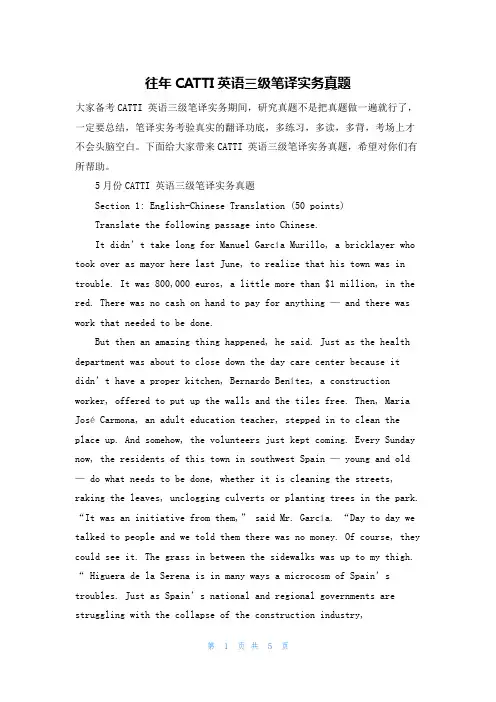
往年CATTI英语三级笔译实务真题大家备考CATTI 英语三级笔译实务期间,研究真题不是把真题做一遍就行了,一定要总结,笔译实务考验真实的翻译功底,多练习,多读,多背,考场上才不会头脑空白。
下面给大家带来CATTI 英语三级笔译实务真题,希望对你们有所帮助。
5月份CATTI 英语三级笔译实务真题Section 1: English-Chinese Translation (50 points)Translate the following passage into Chinese.It didn’t take long for Manuel García Murillo, a bricklayer who took over as mayor here last June, to realize that his town was in trouble. It was 800,000 euros, a little more than $1 million, in the red. There was no cash on hand to pay for anything — and there was work that needed to be done.But then an amazing thing happened, he said. Just as the health department was about to close down the day care center because it didn’t have a proper kitchen, Bernardo Benítez, a construction worker, offered to put up the walls and the tiles free. Then, Maria José Carmona, an adult education teacher, stepped in to clean the place up. And somehow, the volunteers just kept coming. Every Sunday now, the residents of this town in southwest Spain — young and old — do what needs to be done, whether it is cleaning the streets, raking the leaves, unclogging culverts or planting trees in the park. “It was an initiative from them,” said Mr. García. “Day to day we talked to people and we told them there was no money. Of course, they could see it. The grass in between the sidewalks was up to my thigh. “ Higuera de la Serena is in many ways a microcosm of Spain’strou bles. Just as Spain’s national and regional governments are struggling with the collapse of the construction industry,overspending on huge capital projects and a pileup of unpaid bills, the same problems afflict many of its small towns.But what has brought Higuera de la Serena a measure of fame in Spain is that the residents have stepped up where their government has failed. Mr. García says his phone rings regularly from other town officials who want to know how to do the same thing. He is servingwi thout pay, as are the town’s two other elected officials. They are also forgoing the cars and phones that usually come with the job. “We lived beyond our means,” Mr. García said. “We invested in public works thatweren’t sensible. We are in technical bankruptcy.” Even some money from the European Union that was supposed to be used forroutine operating e某penses and last until 2023 has already been spent, he said.Higuera de la Serena, a cluster of about 900 houses surrounded by farmland, and traditionally dependent on pig farming and olives, got swept up in the giddy days of the construction boom. It built a cultural center and invested in a small nursing home. But theprojects were plagued by delays and cost overruns.The cultural center still has no bathrooms. The nursing home, a whitewashed building sits on the edge of town, still unopened. Together, they account for some $470,000 of debt owed to the bank. But the rest of the debt is mostly the unpaid bills of a town that was not keeping up with its e某penses. It owes for medical supplies, for diesel fuel, for road repair, for electrical work, for musicians who played during holidays.Higuera de la Serena is not completely without workers. It still has a half-time librarian, two half-time street cleaners, someonepart-time for the sports comple某, a secretary and an administrator, all of whom are paid through various financing streams apart from the town. But the town once had a work force twice the size. And when someone is ill, volunteers have to step in or the gym and sports comple某— open four hours a day — must close.Section 2: Chinese-English Translation (50 points)Translate the following passage into English.10 年来,中国经济持续快速发展,经济实力、综合国力、人民生活水平迈上新的台阶,国家面貌发生举世瞩目的历史性变化,为促进亚洲和世界经济增长作出了重要贡献。
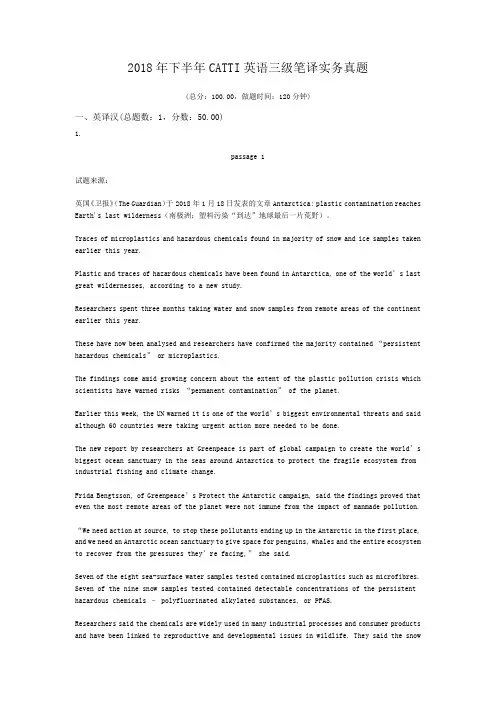
2018年下半年CATTI英语三级笔译实务真题(总分:100.00,做题时间:120分钟)一、英译汉(总题数:1,分数:50.00)1.passage 1试题来源:英国《卫报》(The Guardian)于2018年1月18日发表的文章Antarctica: plastic contamination reaches Earth's last wilderness(南极洲:塑料污染“到达”地球最后一片荒野)。
Traces of microplastics and hazardous chemicals found in majority of snow and ice samples taken earlier this year.Plastic and traces of hazardous chemicals have been found in Antarctica, one of the world’s last great wildernesses, according to a new study.Researchers spent three months taking water and snow samples from remote areas of the continent earlier this year.These have now been analysed and researchers have confirmed the majority contained “persistent hazardous chemicals” or microplastics.The findings come amid growing concern about the extent of the plastic pollution crisis which scientists have warned risks “permanent contamination” of the planet.Earlier this week, the UN warned it is one of the world’s biggest environmental threats and said although 60 countries were taking urgent action more needed to be done.The new report by researchers at Greenpeace is part of global campaign to create the world’s biggest ocean sanctuary in the seas around Antarctica to protect the fragile ecosystem from industrial fishing and climate change.Frida Bengtsson, of Greenpeace’s Protect the Antarctic campaign, said the findings proved that even the most remote areas of the planet were not immune from the impact of manmade pollution.“We need action at source,to stop these pollutants ending up in the Antarctic in the first place, and we need an Antarctic ocean sanctuary to give space for penguins, whales and the entire ecosystem to recover from the pressures they’re facing,” she said.Seven of the eight sea-surface water samples tested contained microplastics such as microfibres. Seven of the nine snow samples tested contained detectable concentrations of the persistent hazardous chemicals – polyfluorinated alkylated substances, or PFAS.Researchers said the chemicals are widely used in many industrial processes and consumer products and have been linked to reproductive and developmental issues in wildlife. They said the snowsamples gathered included freshly fallen snow, suggesting the hazardous chemicals had come from contaminated rain or snowfall.Prof Alex Rogers, a specialist in sustainable oceans at the Oxford Martin school, Oxford University, said the discovery of plastics and chemicals in Antarctica confirmed that manmade pollutants were now affecting ecosystems in every corner of the world.And he warned the consequences of this pervasive contamination remained largely unknown.“The big question now is what are the actual consequences of finding this stuff here? Many of these chemicals are pretty nasty and as they move up the food chain they may be having serious consequences for the health of wildlife, and ultimately humans. The effects of microplastics on marine life, likewise, are largely not understood,” he said.There is relatively little data on the extent of microplastics in Antarctic waters, and researchers said they hoped this new study would lead to a greater understanding of the global extent of plastic and chemical pollutants.Bengtsson said: “Plastic has now been found in all corners of our oce ans, from the Antarctic to the Arctic and at the deepest point of the ocean, the Mariana trench. We need urgent action to reduce the flow of plastic into our seas and we need large-scale marine reserves – like a huge Antarctic ocean sanctuary which over 1.6m people are calling for – to protect marine life and our oceans for future generations.”(分数:50.00)__________________________________________________________________________________________正确答案:(在今年早些时候采集的大部分冰雪样本中发现了微量塑料和有害化学物质。
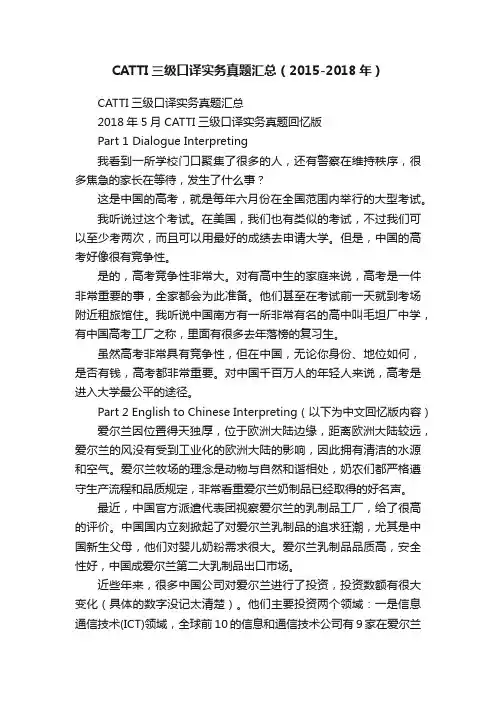
CATTI三级口译实务真题汇总(2015-2018年)CATTI三级口译实务真题汇总2018年5月CATTI三级口译实务真题回忆版Part 1 Dialogue Interpreting我看到一所学校门口聚集了很多的人,还有警察在维持秩序,很多焦急的家长在等待,发生了什么事?这是中国的高考,就是每年六月份在全国范围内举行的大型考试。
我听说过这个考试。
在美国,我们也有类似的考试,不过我们可以至少考两次,而且可以用最好的成绩去申请大学。
但是,中国的高考好像很有竞争性。
是的,高考竞争性非常大。
对有高中生的家庭来说,高考是一件非常重要的事,全家都会为此准备。
他们甚至在考试前一天就到考场附近租旅馆住。
我听说中国南方有一所非常有名的高中叫毛坦厂中学,有中国高考工厂之称,里面有很多去年落榜的复习生。
虽然高考非常具有竞争性,但在中国,无论你身份、地位如何,是否有钱,高考都非常重要。
对中国千百万人的年轻人来说,高考是进入大学最公平的途径。
Part 2 English to Chinese Interpreting(以下为中文回忆版内容)爱尔兰因位置得天独厚,位于欧洲大陆边缘,距离欧洲大陆较远,爱尔兰的风没有受到工业化的欧洲大陆的影响,因此拥有清洁的水源和空气。
爱尔兰牧场的理念是动物与自然和谐相处,奶农们都严格遵守生产流程和品质规定,非常看重爱尔兰奶制品已经取得的好名声。
最近,中国官方派遣代表团视察爱尔兰的乳制品工厂,给了很高的评价。
中国国内立刻掀起了对爱尔兰乳制品的追求狂潮,尤其是中国新生父母,他们对婴儿奶粉需求很大。
爱尔兰乳制品品质高,安全性好,中国成爱尔兰第二大乳制品出口市场。
近些年来,很多中国公司对爱尔兰进行了投资,投资数额有很大变化(具体的数字没记太清楚)。
他们主要投资两个领域:一是信息通信技术(ICT)领域,全球前10的信息和通信技术公司有9家在爱尔兰投资,因此吸引了大量的中国投资者。
另一方面是金融业,中国希望能与爱尔兰方面在金融领域深化合作。
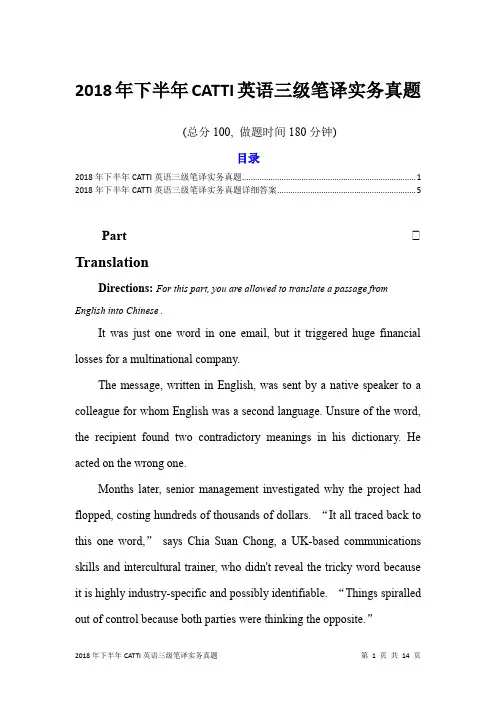
2018年下半年CATTI英语三级笔译实务真题(总分100, 做题时间180分钟)目录2018年下半年CATTI英语三级笔译实务真题 (1)2018年下半年CATTI英语三级笔译实务真题详细答案 (5)Part ⅠTranslationDirections:For this part, you are allowed to translate a passage from English into Chinese .It was just one word in one email, but it triggered huge financial losses for a multinational company.The message, written in English, was sent by a native speaker to a colleague for whom English was a second language. Unsure of the word, the recipient found two contradictory meanings in his dictionary. He acted on the wrong one.Months later, senior management investigated why the project had flopped, costing hundreds of thousands of dollars. “It all traced back to this one word,”says Chia Suan Chong, a UK-based communications skills and intercultural trainer, who didn't reveal the tricky word because it is highly industry-specific and possibly identifiable. “Things spiralled out of control because both parties were thinking the opposite.”When such misunderstandings happen, it’s usually the nativespeakers who are to blame. Ironically, they are worse at delivering their message than people who speak English as a second or third language, according to Chong.A lot of native speakers are happy that English has become the world’s global language. They feel they don’t have to spend time learning another language,”says Chong.The non-native speakers, it turns out, speak more purposefully and carefully, typical of someone speaking a second or third language. Anglophones, on the other hand, often talk too fast for others to follow, and use jokes, slang and references specific to their own culture, says Chong.“The native English speaker is the only one who might not feel the need to accommodate or adapt to the others,”she adds.With non-native English speakers in the majority worldwide, it’s Anglophones who may need to up their game.“Native speakers are at a disadvantage when you are in a lingua franca situation,”where English is being used as a common denominator, says Jennifer Jenkins, professor of global Englishes at the UK’s University of Southampton. “It’s the native English speakers that are having difficulty understanding and making themselves understood.”Non-native speakers generally use more limited vocabulary and simpler expressions, without flowery language or slang. And then there’scultural style, Blattner says. When a Brit reacts to a proposal by saying, “That’s interesting” a fellow Brit might recognise this as understatement for, “That’s rubbish.”But other nationalities would take the word “interesting”on face value, he says.“English speakers with no other language often have a lack of awareness of how to speak English internationally.”In Berlin, Coulter saw German staff of a Fortune 500 company being briefed from their Californian HQ via video link. Despite being competent in English, the Germans gleaned only the gist of what their American project leader said. So among themselves they came up with an agreed version, which might or might not have been what was intended by the California staff.“Too many non-Anglophones, especially the Asians and the French, are too concerned about not ‘losing face’—and nod approvingly while not getting the message at all,”he says.That’s why Nerriere devised Globish —a distilled form of English, stripped down to 1,500 words and simple but standard grammar. “It’s not a language, it’s a tool,”he says. Since launching Globish in 2004 he’s sold more than 200,000 Globish text books in 18 languages.“If you can communicate efficiently with limited, simple language you save time, avoid misinterpretation and you don’t have errors in communication,”Nerriere says.When trying to communicate in English with a group of people with varying levels of fluency, it’s important to be receptive and adaptable, tuning your ears into a whole range of different ways of using English, Jenkins says.“People who’ve learned other languages are good at doing that, but native speakers of English generally are monolingual and not very good at tuning in to language variation,”she says.In meetings, Anglophones tend to speed along at what they consider a normal pace, and also rush to fill gaps in conversation, according to Steggles.He recommends making the same point in a couple of different ways and asking for some acknowledgement, reaction or action.Part ⅡTranslationDirections:For this part, you are allowed to translate a passage from Chinese into English.气候变化已不是单纯的环境保护问题,而成为人类生存与发展问题。
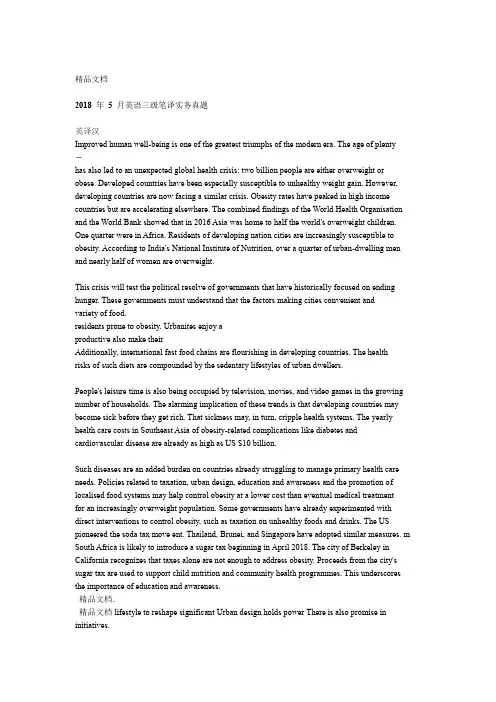
精品文档2018 年5 月英语三级笔译实务真题英译汉Improved human well-being is one of the greatest triumphs of the modern era. The age of plentyhas also led to an unexpected global health crisis: two billion people are either overweight or obese. Developed countries have been especially susceptible to unhealthy weight gain. However, developing countries are now facing a similar crisis. Obesity rates have peaked in high income countries but are accelerating elsewhere. The combined findings of the World Health Organisation and the World Bank showed that in 2016 Asia was home to half the world's overweight children. One quarter were in Africa. Residents of developing nation cities are increasingly susceptible to obesity. According to India's National Institute of Nutrition, over a quarter of urban-dwelling men and nearly half of women are overweight.This crisis will test the political resolve of governments that have historically focused on ending hunger. These governments must understand that the factors making cities convenient andvariety of food.residents prone to obesity. Urbanites enjoy aproductive also make theirAdditionally, international fast food chains are flourishing in developing countries. The health risks of such diets are compounded by the sedentary lifestyles of urban dwellers.People's leisure time is also being occupied by television, movies, and video games in the growing number of households. The alarming implication of these trends is that developing countries may become sick before they get rich. That sickness may, in turn, cripple health systems. The yearly health care costs in Southeast Asia of obesity-related complications like diabetes and cardiovascular disease are already as high as US $10 billion.Such diseases are an added burden on countries already struggling to manage primary health care needs. Policies related to taxation, urban design, education and awareness and the promotion of localised food systems may help control obesity at a lower cost than eventual medical treatmentfor an increasingly overweight population. Some governments have already experimented with direct interventions to control obesity, such as taxation on unhealthy foods and drinks. The US pioneered the soda tax move ent. Thailand, Brunei, and Singapore have adopted similar measures. m South Africa is likely to introduce a sugar tax beginning in April 2018. The city of Berkeley in California recognizes that taxes alone are not enough to address obesity. Proceeds from the city's sugar tax are used to support child nutrition and community health programmes. This underscores the importance of education and awareness.精品文档.精品文档lifestyle to reshape significant Urban design holds power There is also promise in initiatives.patterns and public health. Improving the attractiveness of public space can draw residents out oftheir cars and living rooms. A recent study of urban neighbourhoods in Shanghai and Hangzhouthan better health in walkable neighbourhoods enjoy found that middle-income residents living residents who lived in less walkable neighbourhoods in urban China.tighter should encourage store aisles. Governments Finally, healthier lifestyles begin in grocerySuch vendors. grocers and food connections between agricultural production systems, urban sourcing. This food mechanics of urban help residents better understand the initiatives can alsoraises awareness about the relationship between natural foods and healthy lifestyles. Combining lifestyles controls on unhealthy foods with policies that incentivize healthy eating and activeimportant is an rates. Improving public health to constitute a promising response rising obesitypolicy developing countries should take from both an economic and social point of view. To quotethe recent Global Nutrition Report, reducing obesity will boost global development.改善民生是现代社会最伟大的成就之一。
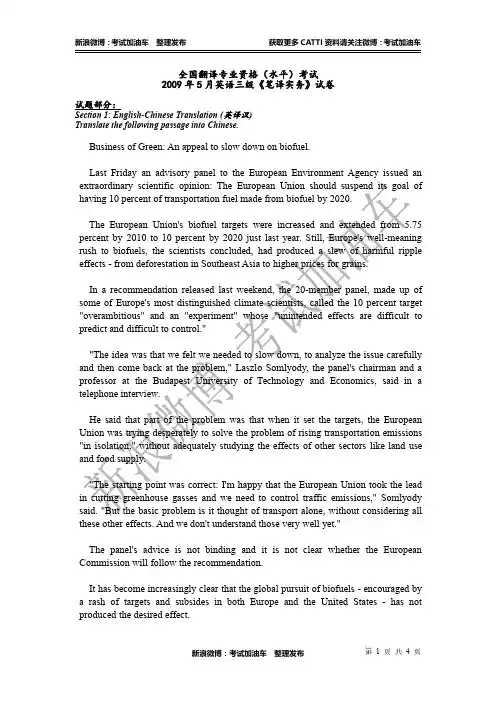
全国翻译专业资格(水平)考试2009年5月英语三级《笔译实务》试卷试题部分:Section1:English-Chinese Translation(英译汉)Translate the following passage into Chinese.Business of Green:An appeal to slow down on biofuel.Last Friday an advisory panel to the European Environment Agency issued an extraordinary scientific opinion:The European Union should suspend its goal of having10percent of transportation fuel made from biofuel by2020.The European Union's biofuel targets were increased and extended from5.75 percent by2010to10percent by2020just last year.Still,Europe's well-meaning rush to biofuels,the scientists concluded,had produced a slew of harmful ripple effects-from deforestation in Southeast Asia to higher prices for grains.In a recommendation released last weekend,the20-member panel,made up of some of Europe's most distinguished climate scientists,called the10percent target "overambitious"and an"experiment"whose"unintended effects are difficult to predict and difficult to control.""The idea was that we felt we needed to slow down,to analyze the issue carefully and then come back at the problem,"Laszlo Somlyody,the panel's chairman and a professor at the Budapest University of Technology and Economics,said in a telephone interview.He said that part of the problem was that when it set the targets,the European Union was trying desperately to solve the problem of rising transportation emissions "in isolation,"without adequately studying the effects of other sectors like land use and food supply."The starting point was correct:I'm happy that the European Union took the lead in cutting greenhouse gasses and we need to control traffic emissions,"Somlyody said."But the basic problem is it thought of transport alone,without considering all these effects.And we don't understand those very well yet."The panel's advice is not binding and it is not clear whether the European Commission will follow the recommendation.It has become increasingly clear that the global pursuit of biofuels-encouraged by a rash of targets and subsides in both Europe and the United States-has not produced the desired effect.Investigations have shown,for example,rain forests and peat swamp are being cleared to make way for biofuel plantations,a process that produces more emissions than the biofuels can save.Equally concerning,land needed to produce food for people to eat is planted with more profitable biofuel crops,and water is diverted from the drinking supply.Europe and the United States,food prices for items like pizza and bread have increased significantly as grain stores shrink and wheat prices rise.The price of wheat and rice are double those of a year ago,and corn is a third higher,the UN Food and Agriculture Organization said this week."Food price inflation hits the poor hardest,as the share of food in their total expenditures is much higher than that of wealthier populations,"said Henri Josserand of the Food and Agriculture Organization.Biofuels are not,of course,the only reason for high food prices.Fuel to transport food is more expensive with oil more than$100a barrel.There have been unexpected droughts this year as well.Should we conclude that all biofuels are bad?No.But motivated by the obvious problems now emerging,scientists have begun to take a harder look at their benefits.For example,the European Environment Agency advisory panel suggests that the best use of plant biomass is not for transport fuel but to heat homes and generate electricity.To be useful for vehicles,plant matter must be distilled to a fuel and often transported long distances.To heat a home,it can often be used raw or with minimal processing,and moved just a short distance away.Section2:Chinese-English Translation(汉译英)Translate the following passage into English.上海作为国际金融中心,拥有繁忙的港口,亚洲最重要的证券市场之一,以及连世界500强都不能忽视的巨大市场。
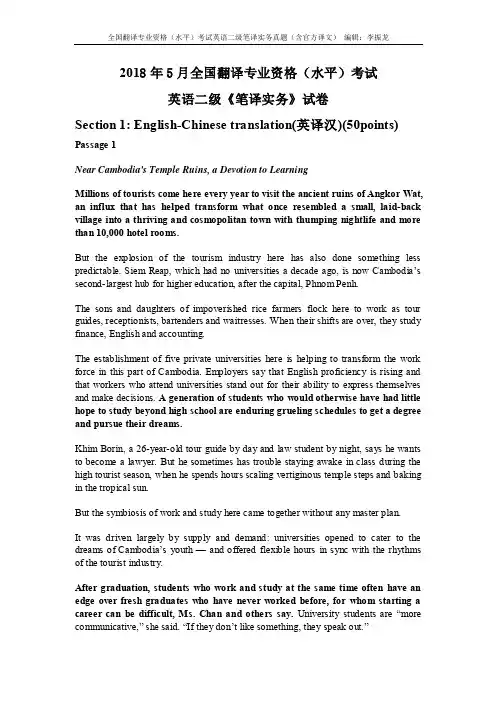
2018年5月全国翻译专业资格(水平)考试英语二级《笔译实务》试卷Section 1: English-Chinese translation(英译汉)(50points) Passage 1Near Cambodia's Temple Ruins, a Devotion to LearningMillions of tourists come here every year to visit the ancient ruins of Angkor Wat, an influx that has helped transform what once resembled a small, laid-back village into a thriving and cosmopolitan town with thumping nightlife and more than 10,000 hotel rooms.But the explosion of the tourism industry here has also done something less predictable. Siem Rea p, which had no universities a decade ago, is now Cambodia’s second-largest hub for higher education, after the capital, Phnom Penh.The sons and daughters of impoverished rice farmers flock here to work as tour guides, receptionists, bartenders and waitresses. When their shifts are over, they study finance, English and accounting.The establishment of five private universities here is helping to transform the work force in this part of Cambodia. Employers say that English proficiency is rising and that workers who attend universities stand out for their ability to express themselves and make decisions. A generation of students who would otherwise have had little hope to study beyond high school are enduring grueling schedules to get a degree and pursue their dreams.Khim Borin, a 26-year-old tour guide by day and law student by night, says he wants to become a lawyer. But he sometimes has trouble staying awake in class during the high tourist season, when he spends hours scaling vertiginous temple steps and baking in the tropical sun.But the symbiosis of work and study here came together without any master plan.It was driven largely by supply and demand: universities opened to cater to the dreams of Cambodia’s youth — and offered flexible hours in sync with the rhythms of the tourist industry.After graduation, students who work and study at the same time often have an edge over fresh graduates who have never worked before, for whom starting a career can be difficult, Ms. Chan and others say. University stud ents are “more communicative,” she said. “If they don’t like something, they speak out.”Ms. Chan and others say they are lucky that Angkor’s temples have proved so popular with tourists. If it were not for the sandstone structures nestled in the jungles, Siem Reap would probably have remained a backwater. Last year, 3.3 million tourists visited Siem Reap, half of them foreigners, according to the Cambodian Ministry of Tourism.Passage 2India's Education Dream Risks Remaining Just ThatAt one of the bett er colleges in India’s capital, there is just one large room for 140 faculty members to sit and have a cup of tea or grade papers. “If even half show up, there aren’t enough chairs,” said Ghazala Amin, a history professor there. “There is no other place to work. In this situation, how do you expect teachers to work?”The lack of amenities for faculty members is not the only issue. After 30 years at Jesus and Mary College, which is one of dozens administered by the University of Delhi, Ms. Amin makes the equivalent of $22,000 a year —less than half of what some of her better students will make in their first jobs. New opportunities offer not just more money for graduates but also mobility and flexibility, which are virtually unheard of for faculty at most of India’s colleges and universities.All this means that India is facing a severe shortage of faculty members. But it is not just low pay and lack of facilities that are being blamed. According to a government report published last year, a massive expansion in higher education combined with a poor supply of Ph.D.’s, delays in recruitment and the lack of incentives to attract and nurture talent has led to a situation in which 40 percent of existing faculty positions remain vacant. The report’s authors, mostly academics, found that if the shortfall is calculated using the class size recommended by the government, this figure jumps to 54 percent.Experts say this is the clearest sign that India will fail to meet the goal set by the education minister, who has pl edged to more than double the size of the country’s higher education system by 2020. They say that while the ambition is laudable, the absence of a long-term strategy to develop faculty will ensure that India’s education dream remains just that.Mr. Balakrishnan of India Institute of Technology in Delhi, meanwhile, was more optimistic. He felt India could enroll as much as 25 percent of eligible students in colleges and universities —about twice the current figure —by 2020.“Tangible changes are happening,” he said. “The debate that has happened in the last few years has taken people out of their comfort zones. There is more consensus across the board that we need to scale quality education.”。
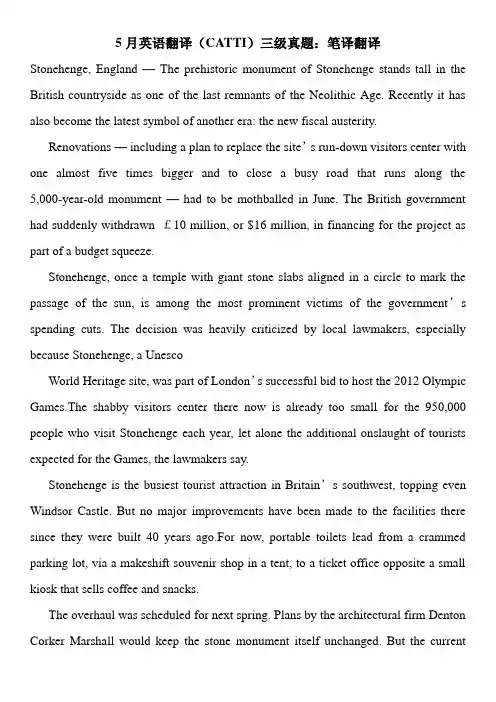
5月英语翻译(CATTI)三级真题:笔译翻译Stonehenge, England —The prehistoric monument of Stonehenge stands tall in the British countryside as one of the last remnants of the Neolithic Age. Recently it has also become the latest symbol of another era: the new fiscal austerity.Renovations — including a plan to replace the site’s run-down visitors center with one almost five times bigger and to close a busy road that runs along the 5,000-year-old monument —had to be mothballed in June. The British government had suddenly withdrawn £10 million, or $16 million, in financing for the project as part of a budget squeeze.Stonehenge, once a temple with giant stone slabs aligned in a circle to mark the passage of the sun, is among the most prominent victims of the government’s spending cuts. The decision was heavily criticized by local lawmakers, especially because Stonehenge, a UnescoWorld Heritage site, was part of London’s successful bid to host the 2012 Olympic Games.The shabby visitors center there now is already too small for the 950,000 people who visit Stonehenge each year, let alone the additional onslaught of tourists expected for the Games, the lawmakers say.Stonehenge is the busiest tourist attraction in Britain’s southwest, topping even Windsor Castle. But no major improvements have been made to the facilities there since they were built 40 years ago.For now, portable toilets lead from a crammed parking lot, via a makeshift souvenir shop in a tent, to a ticket office opposite a small kiosk that sells coffee and snacks.The overhaul was scheduled for next spring. Plans by the architectural firm Denton Corker Marshall would keep the stone monument itself unchanged. But the currentticket office and shop would be demolished and a new visitors center would be built on the other side of the monument, about two and a half kilometers, or 1.5 miles, from the stones.The center would include a shop almost five times the size of the current one, a proper restaurant, three times as many parking spots and an exhibition space to provide more information about Stonehenge’s history.A transit system would shuttle visitors between the center and the stones while footpaths would encourage tourists to walk to the monument and explore the surrounding burial hills. The closed road would be grassed over to improve the surrounding landscape.Last year, the £27 million project won the backing of former Prime Minister Gordon Brown. After more than 25 years of bickering with local communities about how and where to build the new center, planning permission was granted in January. Construction was supposed to start next year and be completed in time for the Olympics — but the economic downturn has changed those plans.The new prime minister, David Cameron, has reversed many of his predecessor’s promises as part of a program to cut more than £99 billion annually over the next five years to help close a gaping budget deficit. The financing for Stonehenge fell in the first round of cuts, worth about £6.2 billion, from the budget for the current year, along with support for a hospital and the British Film Institute.English Heritage, a partly government-financed organization that owns Stonehenge and more than 400 other historic sites in the country, is now aggressively looking for private donations. But the economic downturn has made the endeavor more difficult.Hunched over architectural renderings of the new center, Loraine Knowles, Stonehenge’s project director, said she was disappointed that the government hadwithdrawn money while continuing to support museums in London, like the Tate and the British Museum. But Ms. Knowles said she was hopeful that English Heritage could raise the money elsewhere. Stonehenge, she said, could then also become “a shining example of how philanthropy could w ork.”。
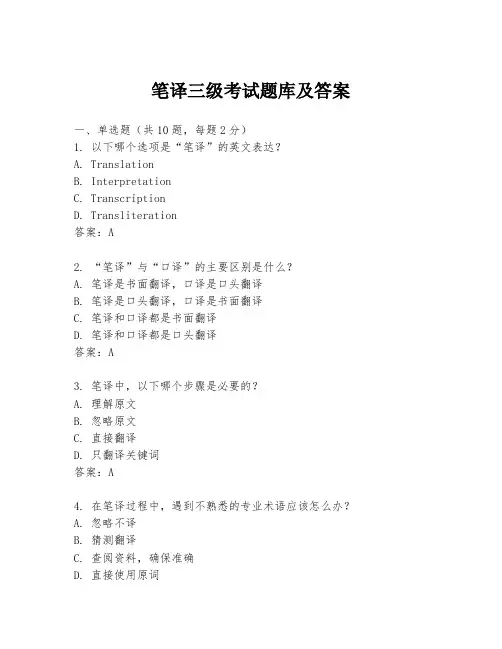
笔译三级考试题库及答案一、单选题(共10题,每题2分)1. 以下哪个选项是“笔译”的英文表达?A. TranslationB. InterpretationC. TranscriptionD. Transliteration答案:A2. “笔译”与“口译”的主要区别是什么?A. 笔译是书面翻译,口译是口头翻译B. 笔译是口头翻译,口译是书面翻译C. 笔译和口译都是书面翻译D. 笔译和口译都是口头翻译答案:A3. 笔译中,以下哪个步骤是必要的?A. 理解原文B. 忽略原文C. 直接翻译D. 只翻译关键词答案:A4. 在笔译过程中,遇到不熟悉的专业术语应该怎么办?A. 忽略不译B. 猜测翻译C. 查阅资料,确保准确D. 直接使用原词答案:C5. 笔译时,以下哪种翻译策略是不恰当的?A. 直译B. 意译C. 逐字翻译D. 灵活变通答案:C6. 笔译中,如何处理原文中的文化元素?A. 直接翻译B. 忽略不译C. 适当解释或注释D. 替换为本国文化元素答案:C7. 笔译三级考试主要考察哪些能力?A. 语言知识B. 翻译技巧C. 文化理解D. 以上都是答案:D8. 笔译三级考试的合格标准是什么?A. 总分达到60分B. 总分达到70分C. 总分达到80分D. 总分达到90分答案:A9. 笔译三级考试中,以下哪个部分是不需要的?A. 阅读理解B. 词汇测试C. 翻译实践D. 数学计算答案:D10. 笔译三级考试的评分标准主要依据什么?A. 翻译速度B. 翻译准确性C. 翻译流畅性D. 以上都是答案:D二、阅读理解(共2篇,每篇5题,每题3分)(文章内容省略)11. 文章主要讨论了什么主题?A. 环境保护B. 经济发展C. 文化交流D. 科技创新答案:C12. 作者认为文化交流的重要性体现在哪些方面?A. 促进经济发展B. 增进相互理解C. 保护文化遗产D. 以上都是答案:D13. 文章中提到的“文化冲突”主要指什么?A. 不同文化之间的竞争B. 不同文化之间的误解C. 不同文化之间的融合D. 不同文化之间的排斥答案:B14. 作者建议如何处理文化冲突?A. 避免交流B. 强制同化C. 尊重差异D. 忽视问题答案:C15. 文章最后呼吁采取什么行动?A. 加强文化保护B. 促进文化融合C. 抵制外来文化D. 限制文化交流答案:B(第二篇阅读理解题目省略)三、翻译实践(共2题,每题15分)16. 将以下句子从英文翻译成中文:"In the context of globalization, cultural exchange plays a vital role in fostering mutual understanding and respect among different nations."答案:在全球化的背景下,文化交流在促进不同国家之间的相互理解和尊重方面发挥着至关重要的作用。
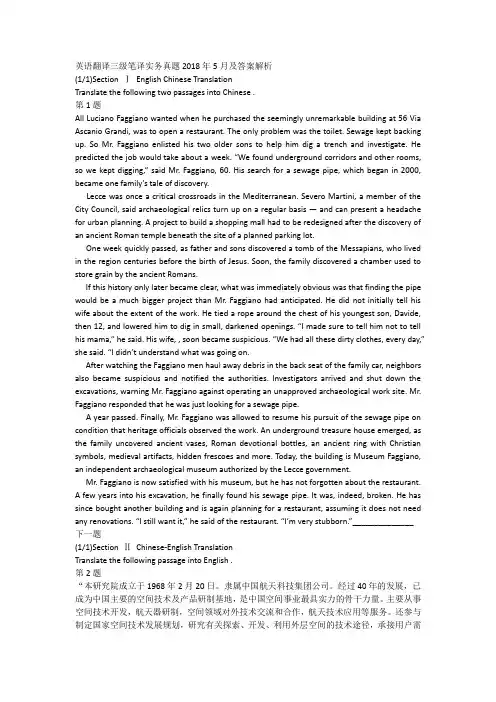
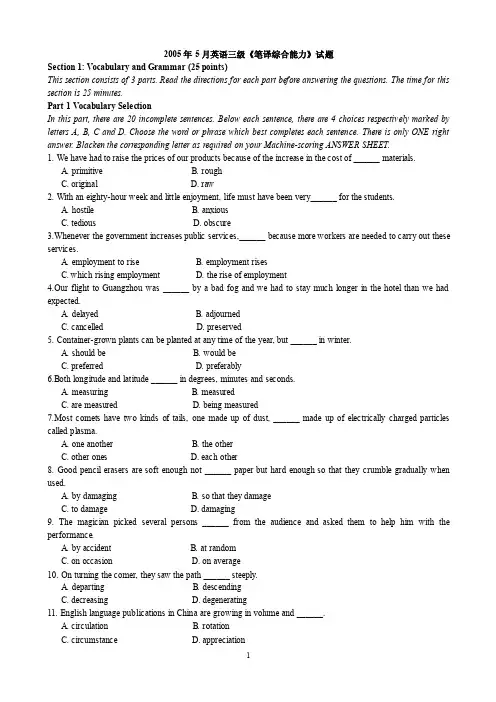
2005年5月英语三级《笔译综合能力》试题Section 1: Vocabulary and Grammar (25 points)This section consists of 3 parts. Read the directions for each part before answering the questions. The time for this section is 25 minutes.Part 1 Vocabulary SelectionIn this part, there are 20 incomplete sentences. Below each sentence, there are 4 choices respectively marked by letters A, B, C and D. Choose the word or phrase which best completes each sentence. There is only ONE right answer. Blacken the corresponding letter as required on your Machine-scoring ANSWER SHEET.1. We have had to raise the prices of our products because of the increase in the cost of ______ materials.A. primitiveB. roughC. originalD. raw2. With an eighty-hour week and little enjoyment, life must have been very______ for the students.A. hostileB. anxiousC. tediousD. obscure3.Whenever the government increases public services,______ because more workers are needed to carry out these services.A. employment to riseB. employment risesC. which rising employmentD. the rise of employment4.Our flight to Guangzhou was ______ by a bad fog and we had to stay much longer in the hotel than we had expected.A. delayedB. adjournedC. cancelledD. preserved5. Container-grown plants can be planted at any time of the year, but ______ in winter.A. should beB. would beC. preferredD. preferably6.Both longitude and latitude ______ in degrees, minutes and seconds.A. measuringB. measuredC. are measuredD. being measured7.Most comets have two kinds of tails, one made up of dust, ______ made up of electrically charged particles called plasma.A. one anotherB. the otherC. other onesD. each other8. Good pencil erasers are soft enough not ______ paper but hard enough so that they crumble gradually when used.A. by damagingB. so that they damageC. to damageD. damaging9. The magician picked several persons ______ from the audience and asked them to help him with the performance.A. by accidentB. at randomC. on occasionD. on average10. On turning the comer, they saw the path ______ steeply.A. departingB. descendingC. decreasingD. degenerating11. English language publications in China are growing in volume and ______.A. circulationB. rotationC. circumstanceD. appreciation12.Hydroponics ______ the cultivation of plants without soil.A. doesB. isC. doD. are13. To impose computer technology ______ teachers is to create an environment that is not conducive to learning.A. withB. toC. inD. on14. Marketing is ______ just distributing goods from the manufacturer to the final customer.A. rather thanB. other thanC. bigger thanD. more than15.______ a language family is a group of languages with a common origin and similar vocabulary, grammar, and sound system.A. What linguists callB. It is called by linguistsC. Linguists call itD. What do linguists call16. In the eighteenth century, the town of Bennington, V ermont, was famous for ______ pottery.A. it madeB. itsC. the makingD. where its17.______ get older, the games they play become increasingly complex.A. ChildrenB. Children, when theyC. As childrenD. For children to18. ______ of his childhood home in Hannibal, Missouri, provided Mark Twain with the inspiration for two of his most popular novels.A. RememberingB. MemoriesC. It was the memoriesD. He remembered19. Dust storms most often occur in areas where the ground has little vegetation to protect ______ of the wind.A. from the effectsB. it the effectsC. it from the effectsD. the effects from it20. Most nurses are women, but in the higher ranks of the medical profession women are a ______.A. scarcityB. minorityC. minimumD. shortagePart 2 Vocabulary ReplacementThis part consists of 15 sentences; in each sentence one word or phrase is underlined. Below each sentence, there are 4 choices respectively marked by letters A, B, C and D. Choose the word or phrase that can replace the underlined part without causing any grammatical error or changing the basic meaning of the sentence. There is only ONE right answer. Blacken the corresponding letter as required on your Machine-scoring ANSWER SHEET.21. Shellfish give the deceptive appearance of enjoying a peaceful existence, although in fact life is a constant struggle for them.A. misleadingB. calmC. understandableD. initial22. The most striking technological success in the 20th century is probably the computer revolution.A. profitableB. productiveC. prominentD. prompt23. Scientific evidence from different disciplines demonstrates that in most humans the left hemisphere of the brain controls language.A. groups of followersB. yearsC. countriesD. fields of study24. Public relations practice is the deliberate, planned and sustained effort to establish and maintain mutual understanding between an organization and its public.A. completeB. relatedC. intentionalD. active25.The use of the new technology will have a profound effect on schools.A. negativeB. positiveC. strongD. useful26. If we look at the Chinese and British concepts of hospitality, we find one major similarity but a number of important differences.A. hostilityB. friendlinessC. mannerD. culture27. In just three years, the Net has gone from a playground for the local people to a vast communications and trading center where millions swap information or do deals around the world.A. businessB. shoppingC. chattingD. meeting28. Most species of this plant thrive in ordinary well-drained garden soil and they are best planted 8 cm deep and5 cm apart.A. develop wellB. grow tallerC. matureD. bear fruit29. Motivation is the driving force within individuals that impels them to action.A. impedesB. interferesC. holdsD. pushes30. The ultimate cause of the Civil War was the bombardment of Fort Sumter.A. onlyB. finalC. trueD. special31. No hero of ancient or modern days can surpass the Indians with their lofty contempt of death and the fortitude with which they sustain its cruelest affliction.A. regardB. courageC. lossD. trick32. The service economy doesn't suggest that we convert our factories into laundries to survive.A. implyB. persuadeC. hurlD. transform33. It was rather strange how the habits of his youth clung to him still. He was 72.A. stuck toB. turnedC. led toD. gave way to34. He has a touch of eccentricity in his composition.A. essayB. writingC. characterD. manner35. Jim was a stout old gentleman, with a weather-beaten countenance.A. bodyB. skinC. shoulderD. passionate interestPart 3 Error CorrectionThis part consists of 15 sentences; in each sentence there is an underlined part that indicates an error. Below each sentence, there are 4 choices respectively marked by letters A, B, C and D. Choose the word or phrase that can replace the underlined part so that the error is corrected. There is only ONE right answer. Blacken the corresponding letter as required on your Machine-scoring ANSWER SHEET.36. Not much people realize that apples have been cultivated for over 3,000 years.A. Not manyB. Not enoughC. Without manyD. No many37.The eastern bluebird is considered the most attractive bird native of North America by many bird-watchers.A. nativeB. native withC. native byD. native to38. All living creatures pass on inherited traits from one generation to other.A. the otherB. anotherC. othersD. other one39. Furniture makers use glue to hold joints together and sometimes to reinforce it.A. itsB. fastC. hardD. them40.The hard, out surface of the tooth is called enamel.A. outsideB. appearanceC. outerD. hiding41. The earliest form of artificial lighting was fire, which also provided warm and protection.A. hotB. sunshineC. warmthD. safe42. All mammals have hair, but not always evident.A. but it is notB. but it isC. but they are notD. but they are43.A professor of economic and history at Atlanta University, W.E.B. Du Bois, promoted full racial equality.A. economyB. economicsC. economicalD. economic44. Machines that use hydraulic pressure including elevators, dentist chairs, and automobile brakes.A. excludeB. excludingC. includeD. are included45. The first recorded use of natural gas to light street lamps it was in the town of Frederick, New Y ork, in 1825.A. wasB. isC. it isD. were46. Although the social sciences different a great deal from one another, they share a common interest in human relationship.A. moveB. differC. changeD. varies47. Unlike competitive running, race walkers must always keep some portion of their feet in contact with the ground.A. runB. runnerC. runnersD. running race48. A promising note is a written agreement to pay a certain sum of money at some time future.A. time futuresB. futuresC. futures timeD. future time49. New Y ork City surpassed the other Atlantic seaports in partly because it developed the best transportation links with the interior of the country.A. partB. partialC. partnerD. parting50. All root vegetables grow underground, and not all vegetables that grow underground are roots.A. butB. orC. asD. thusSection 2: Reading Comprehension (55 points)In this section you will find after each of the passages a number of questions or unfinished statements about the passage, each with 4 (A, B, C and D) choices to complete the statement. You must choose the one which you think fits best. Then blacken the corresponding letter as required on your Machine-scoring ANSWER SHEET. The time for this section is 75 minutes.Phyllis Wheatley is regarded as America's first black poet. She was born in Senegal, Africa, about 1753 and brought to America aboard a slave ship at about the age of seven. John and Susannah Wheatley bought her for three pounds at a slave auction in Boston in 1761 to be a personal servant of Mrs. Wheatley. The family had three other slaves, and all were treated with respect. Phyllis was soon accepted as one of the family, which included being raised and educated with the Wheatley's twin 15-year-old children, Mary and Nathaniel. At that time, most females, even from better families, could not read and write, but Mary was probably one of the best educated young women in Boston. Mary wanted to become a teacher, and in fact, it was Mary who decided to take chargeof Phyllis's education. Phyllis soon displayed her remarkable talents. At the age of twelve she was reading the Greek and Latin classics and passages from the Bible. And eventually. Mrs. Wheatley decided Phyllis should become a Christian.At the age of thirteen Phyllis wrote her first poem. She became a Boston sensation after she wrote a poem on the death of the evangelical preacher George Whitfield in 1770. It became common practice in Boston to have "Mrs. Wheatley's Phyllis" read poetry in polite society. Mary married in 1771, and Phyllis later moved to the country because of poor health, as a teacher and caretaker to a farmer's three children. Mary had tried to interest publishers in Phyllis's poems but once they heard she was a Negro they weren't interested.Then in 1773 Phyllis went with Nathaniel, who was now a businessman, to London. It was thought that a sea voyage might improve her health. Thirty-nine of her poems were published in London as Poems on V arious Subjects, Religious and Moral. It was the first book published by a black American. In 1775 Phyllis wrote a poem extolling the accomplishments of George Washington and sent it to him. He responded by praising her talents and inviting her to visit his headquarters. After both of her benefactors died in 1777, and Mary died in 1778, Phyllis was freed as a slave. She married in 1778, moved away from Boston, and had three children. But after the unhappy marriage, she moved back to Boston, and died in poverty at the age of thirty.51. What does the passage mainly discuss?A. Slavery and the treatment of the black people in America.B. The Wheatley family, including their slaves.C. The life of America's first black poet.D. The achievements of Phyllis Wheatley.52. The underlined word "respect" in Paragraph 1 is closest in meaning to ______.A. considerationB. disregardC. punishmentD. behavior53. According to the passage, how many slaves did the Wheatley's have?A. One.B. Two.C. Three.D. Four.54. According to the passage, an unusual feature of Mary was that she ______.A. was not much older than PhyllisB. wanted to become a teacherC. was comparatively well educatedD. decided to take charge of Phyllis's education55. The underlined word "eventually" in Paragraph 1 is closest in meaning to ______.A. ultimatelyB. slowlyC. reluctantlyD. gradually56.Which of the following is NOT true about Phyllis in the early 1770s?A. She wrote her first poem when in her teens.B. She married in 1771.C. She became a teacher.D. She was able to get her poems published.57. The underlined word "they" in Paragraph 2 refers to ______A. publishersB. poemsC. childrenD. black people58.It can be inferred that Phyllis's trip to England with Nathaniel in 1773 ______A. did not improve her healthB. was for business reasonsC. led to books of her poems being available in AmericaD. led to the publication of her poems because the English were more interested in religious and moral subjects59. The word "extolling" is closest in meaning to ______A. welcomingB. statingC. bemoaningD. praising60. Which of the following conclusions about Phyllis is supported by the passage?A. She would have been more recognized as a poet if she had not been black.B. She would have written poetry if she had stayed in Africa.C. She went unrecognized as a poet during her lifetime.D. She only wrote religious poetry.Questions 61-70About fifty years ago, plant physiologists set out to grow roots by themselves in solutions in laboratory flasks. The scientists found that the nutrition of isolated roots was quite simple. They required sugar and the usual minerals and vitamins. However, they did not require organic nitrogen compounds. These roots got along fine on mineral inorganic nitrogen. Roots are capable of making their own proteins and other organic compounds. These activities by roots require energy, of course: The process of respiration uses sugar to make the high energy compound A TP, which drives the biochemical reactions. Respiration also requires oxygen. Highly active roots require a good deal of oxygen.The study of isolated roots has provided an understanding of the relationship between shoots and roots in intact plants. The leaves of the shoots provide the roots with sugar and vitamins, and the roots provide the shoots with water and minerals. In addition, roots can provide the shoots with organic nitrogen compounds. This comes in handy for the growth of buds in the early spring when leaves are not yet functioning. Once leaves begin photosynthesizing, they produce protein, but only mature leaves can "export" protein to the rest of the plant in the form of amino acids.61.What is the main topic of the passage?A. The relationship between a plant's roots and its shoots.B. What can be learned by growing roots in isolation.C. How plants can be grown without roots.D. What elements are necessary for the growth of plants.62.The underlined word "themselves" in Paragraph 1 refers to ______A. plant physiologistsB. solutionsC. laboratory flasksD. roots63.The scientists found what the isolated roots need is ______A. quite naturalB. sugar, minerals and vitaminsC. some rare vitaminsD. organic nitrogen compounds64.Roots have the ability to ______A. make proteinsB. obtain fresh airC. produce inorganic nitrogenD. carry out activities without energy65.According to the passage, what is A TP?A. A biochemical process.B. The tip of a root.C. A chemical compound.D. A type of plant cell.66.The underlined word "intact" in Paragraph 2 is closest in meaning to ______A. matureB. wildC. wholeD. tiny67. The use of the phrase "comes in handy" underlined in Paragraph 2 indicates that the process is ______A. unavoidableB. predictableC. necessaryD. successful68. It can be inferred from the passage that, in the early spring, the buds of plants ______A. "export" protein in the form of amino acidsB. do not require waterC. have begun photosynthesizingD. obtain organic compounds from the root69. Which of the following best describes the organization of the passage?A. The results of two experiments are compared.B. A generalization is made, and several examples of it are given.C. The findings of an experiment are explained.D. A hypothesis is presented, and several means of proving it are suggested.70.Where is this passage likely to be found?A. A newsletter.B. A magazine.C. A storybook.D. A novel.Questions 71-80Natural flavorings and fragrances are often costly and limited in supply. For example, the vital ingredient in a rose fragrance is extracted from natural rose oil at a cost of thousands of dollars a pound; an identical synthetic substance can be made for 1% of this cost. Since the early twentieth century, success in reproducing these substances has created a new industry that today produces hundreds of artificial flavors and fragrances.Some natural fragrances are easily synthesized; these include vanillin, the aromatic ingredient in vanilla, and benzaldehyde, the aromatic ingredient in wild cherries. Other fragrances, however, have dozens, even hundreds of components. Only recently has it been possible to separate and identit3, these ingredients by the use of gas chromatography and spectroscopy. Once the chemical identity is known, it is often possible to synthesize them. Nevertheless, some complex substances, such as the aroma of fresh coffee, have still not been duplicated satisfactorily.Many of the chemical compounds making up these synthetics are identical to those found in nature, and are as harmless or harmful as the natural substances. New products must be tested for safety, and when used in food, must be approved by the U.S. Food and Drug Administration.The availability of synthetic flavors and fragrances has made possible a large variety of products, from inexpensive beverages to perfumed soap to used cars with applied "new car odor."71.From the passage we can learn that ______A. natural flavorings and fragrances are not quite dearB. the limitation of natural flavorings and fragrances is clearC. the supply of natural flavorings and fragrances is adequate to meet the demandD. the cost of producing natural flavorings and fragrances is high72. Which of the following is true according to the passage?A. Natural rose fragrance is 100 times more expensive to produce than artificial rose fragrance.B. The most important ingredient in a rose fragrance is obtained from natural rose oil at a low cost.C. A different synthetic substance can be made for 1% of the cost.D. Natural rose oil costs the same as its fragrances.73. The industry of producing hundreds of artificial flavors and fragrances probably appeared in ______A. 2000B. 1953C. 1909D. 181074. According to the passage, all the following are easier to synthesize EXCEPT ______A. aromatic ingredient in vanillaB. vanillaC. aromatic ingredient in wild cherryD. the flavor of fresh coffee75. The underlined word "duplicated" in Paragraph 2 is closest in meaning to ______A. make doubleB. make a copy ofC. produce something equal toD. take from76. Why does the author mention fresh coffee in Paragraph 2?A. As an example of complex substances having not been duplicated satisfactorily.B. Because the coffee fragrance is hard to produce.C. To conclude the passage.D. The smell of fresh coffee is inviting.77. ______ a substance can be synthesized.A. Upon identifying the basic components of itB. Once chemically analyzedC. When gas chromatography is usedD. If spectroscopy is adopted78. It can be inferred from the passage that ______A. vanillin is easier to synthesize than benzaldehydeB. not all synthetic flavors are harmlessC. in general, the less components there are in a fragrance, the harder it is to synthesizeD. synthesized substances must be tested for safety only if they are used in food79.Which of the following is the best title for tile passage?A. How to Synthesize FragrancesB. Synthetic Substances Are Easy to MakeC. Natural Flavorings and FragrancesD. Synthetic Flavors and Fragrances80. Which of the following is NOT true according to the last paragraph?A. Synthetic fragrances can be used to make a used car smell like a new one.B. Synthetic flavors and fragrances have added to the varieties of products.C. Lemon soap is made out of some delicious lemon.D. It is likely that a bottle of orange juice is synthesized.Questions 81-90Some people associate migration mainly with birds. Birds do travel vast distances, but mammals also migrate. An example is the caribou, reindeer that graze on the grassy slopes of northern Canada. When the weather turns cold, they travel south until spring. Their tracks are so well-worn that they are clearly visible from the air. Another migrating mammal is the Alaska fur seal. These seals breed only in the Pribilot Islands in the Bering Sea. The young are born in June and by September are strong enough to go with their mothers on a journey of over 3,000 miles. Together they swim down the Pacific Coast of North America. The females and young travel as far as southern California. The males do not journey so far. They swim only to the Gulf of Alaska. In the spring, males and females all return to the islands, and there the cycle begins again. Whales are among the greatest migrators ofall. The humpback and blue whales migrate thousands of miles each year from the polar seas to the tropics. Whales eat huge quantities of plankton. These are most abundant in cold polar waters. In winter, the whales move to warm waters to breed and give birth to their young.81. From the passage we can learn that ______A. people migrate like animalsB. only birds migrateC. the female fur seals migrate only to the Gulf of AlaskaD. not all mammals migrate82. The phrase "An example" underlined in Paragraph 1 refers to an example of a ______A. migratory mammalB. place where animals migrateC. migrating birdD. person who associates migration with birds83. All the mammals are mentioned as migrating ones EXCEPT ______A. caribouB. fin whaleC. reindeerD. Alaska fur seal84. Where can you see from the air the migration of the mammals?A. In the Pribilot Islands.B. In the Bering Sea.C. In southern California.D. In northern Canada.85. Which of the following is NOT true?A. Whales breed in winter.B. Y oung whales are given birth in cold waters.C. Alaska fur seals give birth to the young only in one area.D. Alaska fur seals are born in warm weather.86. Together ______ of Alaska fur seals swim down the Pacific Coast of North America.A. mothers and the youngB. fathers and the youngC. parents and the youngD. seals and whales87. Which of the following is NOT described in the passage?A. Whales migrate to breed and give birth to their young.B. Whale-watching in Boston in summer is attracting.C. Seals breed in the north before migration.D. Reindeer feed on grass.88. Whales live on ______A. tiny plants and animals in the seaB. the grassy slopes of northern CanadaC. their young in cold winterD. the abundant seafood in tropic waters89. How many kinds of migrating mammals are mentioned in the passage?A. Four.B. Three.C. Two.D. One.90. What is the best title of the passage?A. Three Types of WhalesB. Birds MigrationC. Mammals Also MigrateD. Several Kinds of MigrationQuestions 91-100Electronic mail has become an extremely important and popular means of communication.The convenience and efficiency of electronic mail are threatened by the extremely rapid growth in the volume of unsolicited commercial electronic mail. Unsolicited commercial electronic mail is currently estimated to account for over half of all electronic mall traffic, up from an estimated 7 percent in 2001, and the volume continues to rise. Most of these messages are fraudulent or deceptive in one or more respects.The receipt of unsolicited commercial electronic mail may result in costs to recipients who cannot refuse to accept such mail and who incur costs for the storage of such mail, or for the time spent accessing, reviewing, and discarding such mail, or for both. The receipt of a large number of unwanted messages also decreases the convenience of electronic mall and creates a risk that wanted electronic mail messages, both commercial and noncommercial, will be lost, overlooked, or discarded amidst the larger volume of unwanted messages, thus reducing the reliability and usefulness of electronic mail to the recipient. Some commercial electronic mail contains material that many recipients may consider vulgar or pornographic in nature.The growth in unsolicited commercial electronic mail imposes significant monetary costs on providers of Internet access services, businesses, and educational and nonprofit institutions that carry and receive such mail, as there is a finite volume of mail that such providers, businesses, and institutions can handle without further investment in infrastructure. Many senders of unsolicited commercial electronic mail purposefully disguise the source of such mall.Many senders of unsolicited commercial electronic mall purposefully include misleading information in the messages' subject lines in order to induce the recipients to view the messages. While some senders of commercial electronic mail messages provide simple and reliable ways for recipients to reject (or 'opt-out' of) receipt of commercial electronic mall from such senders in the future, other senders provide no such 'opt-out' mechanism, or refuse to honor the requests of recipients not to receive electronic mail from such senders in the future, or both.Many senders of bulk unsolicited commercial electronic mail use computer programs to gather large numbers of electronic mail addresses on an automated basis from Internet websites or online services where users must post their addresses in order to make full use of the website or service.The problems associated with the rapid growth and abuse of unsolicited commercial electronic mall cannot be solved by the government alone. The development and adoption of techno-logical approaches and the pursuit of cooperative efforts with other countries will be necessary as well.91. According to the passage, efficiency of e-mail is threatened by ______A. heavy e-mail trafficB. fraudulent e-mail messagesC. large volume of messagesD. increasing amount of unwanted e-mail92.Which of the following is NOT true about unwanted e-mail?A. It costs money to receive them.B. It's free to store them.C. It takes time to access them.D. It takes time to throw them away.93. Unwanted e-mail may ______A. cause companies to fail in businessB. cause wanted e-mail messages to loseC. damage the credit of a companyD. do good to a small company94. "Pornographic" in Paragraph 3 probably means ______A. decentB. instructionalC. sexualD. commercial。
5月翻译资格考题三级英语笔译实务试卷及答案试题部分:Section 1: English-Chinese Translation (英译汉) Translate the following passage into Chinese.Freed by warming, waters once locked beneath ice are gnawing at coastal settlements around the Arctic Circle.In Bykovsky, a village of 457 residents at the tip of a fin-shaped peninsula on Russia's northeast coast, the shoreline is collapsing, creeping closer and closer to houses and tanks of heating oil,at a rate of 15 to 18 feet, or 5 to 6 meters, a year. Eventually, homes will be lost as more ice melts each summer, and maybe all of Bykovsky, too.“It is practically all ice — permafrost —and it is thawing. ” The 4 million Russian people who live north of the Arctic Circle are feeling the effects of warming in many ways. A changing climate presents new opportunities, but it also threatens their environment, the stability of their homes, and,for those whose traditions rely on the ice-bound wilderness, the preservation of their culture.A push to develop the North, quickened by the melting of the Arctic seas, carries its own rewards and dangers for people in the region. Discovery of vast petroleum fields in the Barents and Kara Seas has raised fears of catastrophic accidents as ships loaded with oil or liquefied gas churn through the fisheries off Scandinavia, headed for the eager markets of Europe and North America. Land that was untouched could be tainted by air and water pollution as generators, smokestacks and large vehicles sprout to support the growing energy industry.Coastal erosion is a problem in Alaska as well, forcing the United States to prepare to relocate several Inuit coastal villages at a projected cost of US $ 100 million or more for each one.Across the Arctic, indigenous tribes with cultural traditions shaped by centuries of living in extremes of cold and ice are noticing changes in weather and wildlife. They are trying to adapt, but it can be confounding.In Finnmark, the northernmost province of Norway, the Arctic landscape unfolds in late winter as an endless snowy plateau, silent but for the cries of the reindeer and the occasional whine of a snowmobile herding them.A changing Arctic is felt there, too, though in another way. "The reindeer arebecoming unhappy," said Issat Eira, a 31-year-old reindeer herder.Few countries rival Norway when it comes to protecting the environment and preserving indigenous customs. The state has lavished its oil wealth on the region, and as a result Sami culture has enjoyed something of a renaissance.And yet no amount of government support can convince Eira that his livelihood, intractably entwined with the reindeer, is not about to change. Like a Texas cattleman he keeps the size of his herd secret. But he said warmer temperatures in fall and spring are melting the top layers of snow, which then refreeze as ice, making it harder for his reindeer to dig through to the lichen they eat."The people who are making the decisions, they are living in the south and they are living in towns,”said Eira, sitting beside a birch fire inside his lavvu, a home made of reindeer hides. "They don't mark the change of weather. It is only people who live in nature and get resources from nature who mark it. ”Section 2: Chinese-English Translation (汉译英) Translate the following passage into English.维护世界和平,促进共同发展,谋求合作共赢,是各国人民的共同愿望,也是不可抗拒的当今时代潮流。
2018年5月翻译资格考试CATTI三级笔译真题及答案英译汉Improved human well-being is one of the greatest triumphs of the modern era.The age of plenty has also led to an unexpected global health crisis: two billionpeople are either overweight or obese. Developed countries have been especiallysusceptible to unhealthy weight gain. However, developing countries are now facing a similar crisis. Obesity rates have peaked in high income countries but are accelerating elsewhere. The combined findings of the World Health Organisation and the World Bank showed that in 2016 Asia was home to half the world’s overweight children. One quarter were in Africa. Residents of developing nation cities are increasingly susceptible to obesity. According to India’s National Institute of Nutrition, over a quarter of urban-dwelling men and nearly half of women are overweight.民生改善是现代最伟大的成就之一。
2018年5月翻译资格考试三级英语笔译实务真题英译汉Improved human well-being is one of the greatest triumphs of the modern era. The age of plenty has also led to an unexpected global health crisis:two billion people are either overweight or obese. Developed countries have been especially susceptible to unhealthy weight gain.However, developing countries are now facing a similar crisis. Obesity rates have peaked in high income countries but are accelerating elsewhere. The combined findings of the World Health Organisation and the World Bank showed that in 2016 Asia was home to half the world’s overweight children. One quarter were in Africa. Residents of developing nation cities are increasingly susceptible to obesity. According to India’s National Institute of Nutrition, over a quarter of urban-dwelling men and nearly half of women are overweight.The majority of the world’s future urbanisation is projected to occur in developing countries, particularly in Asia and Africa. This crisis will test the political resolve of governments that have historically focused on ending hunger. These governments must understand that the factors making cities convenient and productive also make their residents prone to obesity. Urbanites enjoy a variety of food. Additionally, international fast food chains are flourishing in developing countries. The health risks of such diets are compounded by the sedentary lifestyles of urban dwellers. People’s leisure time is also beingoccupied by television, movies, and video games in the growing number of households.The alarming implication of these trends is that developing countries may become sick before they get rich. That sickness may, in turn, cripple health systems.The yearly health care costs in Southeast Asia of obesity-related complications like diabetes and cardiovascular disease are already as high as US $10 billion. Such diseases are an added burden on countries already struggling to manage primary health care needs.Policies related to taxation, urban design, education and awareness and the promotion of localised food systems may help control obesity at a lower cost than eventual medical treatment for an ageing and increasingly overweight population.Some governments have already experimented with direct interventions to control obesity, such as taxation on unhealthy foods and drinks. The US pioneered the soda tax movement. Thailand, Brunei, and Singapore have adopted similar measures. South Africa is likely to introduce a sugar tax beginning in April 2018.The city of Berkeley in California recognizes that taxes alone are not enough to address obesity. Proceeds from the city’s sugar tax are used to support child nutrition and community health programmes. This underscores the importance of education and awareness.There is also promise in initiatives. Urban design holds significant power to reshape lifestyle patterns and public health. Improving the attractiveness ofpublic space can draw residents out of their cars and living rooms. A recent study of urban neighbourhoods in Shanghai and Hangzhou found that middle-income residents living in less walkable neighbourhoods had significantly higher Body Mass Indices than both richer and poorer residents who lived in walkable neighbourhoods in urban China.Finally, healthier lifestyles begin in grocery store aisles. Governments should encourage tighter connections between agricultural production systems, urban grocers and food vendors. Such initiatives can also help urban residents better understand the mechanics of food sourcing. This raises awareness about the relationship between natural foods and healthy lifestyles. Combining controls on unhealthy foods with policies that incentivise healthy eating and active lifestyles constitute a promising response to rising obesity rates. Improving public health is an important policy developing countries should take from both an economic and social point of view. To quote the recent Global Nutrition Report, reducing obesity will boost global development.汉译英煤炭是地球上储量最为丰富的能源,但反对使用煤炭的声浪日益高涨。
煤炭巨大的碳排放量引起气候变化,从而引起公众的担忧。
煤炭与其他能源相比,竞争力已经有所下降了。
以美国为例,页岩气的出现造成部分出煤量因价格过高而被挤出市场。
美国去年煤炭需求接近9.2亿吨。
由于天然气价格下跌,今年美国煤炭需求将减少6000万到8000万吨。
数据显示,煤炭满足了全球大约30%的能源需求,提供40%以上的电力。
在人口第一和第二大国中国和印度,煤炭所满足的能源需求比例甚至达到70%左右。
中国的煤炭消费量在去年已经下滑,煤炭进口下降了11%,这是十年来的首次下降。
中国经济增速已经放缓,同时也做出极大努力削减煤炭使用以减少煤炭污染。
由于燃煤发电厂没有满负荷运行,再加上煤炭供应充足,造成国际煤炭价格压低。
煤出口价格从去年的峰值下跌了约60%。